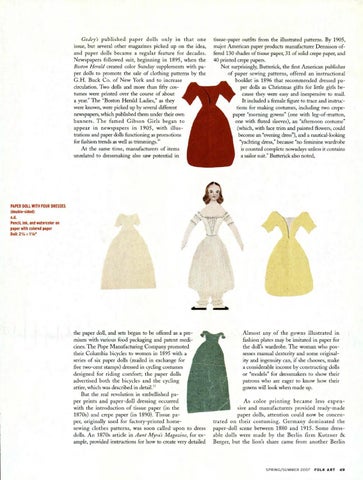Godey's published paper dolls only in that one issue, but several other magazines picked up on the idea, and paper dolls became a regular feature for decades. Newspapers followed suit, beginning in 1895, when the Boston Herald created color Sunday supplements with paper dolls to promote the sale of clothing patterns by the G.H. Buck Co. of New York and to increase circulation. Two dolls and more than fifty costumes were printed over the course of about a year.' The "Boston Herald Ladies," as they were known,were picked up by several different newspapers,which published them under their own banners. The famed Gibson Girls began to appear in newspapers in 1905, with illustrations and paper dolls functioning as promotions for fashion trends as well as trimmings." At the same time, manufacturers of items unrelated to dressmaking also saw potential in
tissue-paper outfits from the illustrated patterns. By 1905, major American paper products manufacturer Dennison offered 130 shades oftissue paper, 31 of solid crepe paper, and 40 printed crepe papers. Not surprisingly, Butterick, the first American publisher of paper sewing patterns, offered an instructional booklet in 1896 that recommended dressed paper dolls as Christmas gifts for little girls because they were easy and inexpensive to mail. It included a female figure to trace and instructions for making costumes, including two crepepaper "morning gowns"(one with leg-of-mutton, one with fluted sleeves), an "afternoon costume" (which, with lace trim and painted flowers, could become an "evening dress"), and a nautical-looking "yachting dress," because "no feminine wardrobe is counted complete nowadays unless it contains a sailor suit." Butterick also noted,
PAPER DOLL WITH FOUR DRESSES (double-sided) n.d. Pencil, ink, and watercolor on paper with colored paper Doll: 21/4 x 11 / 2"
411miim
the paper doll, and sets began to be offered as a premium with various food packaging and patent medicines.The Pope Manufacturing Company promoted their Columbia bicycles to women in 1895 with a series of six paper dolls (mailed in exchange for five two-cent stamps) dressed in cycling costumes designed for riding comfort; the paper dolls advertised both the bicycles and the cycling attire, which was described in detail.' But the real revolution in embellished paper prints and paper-doll dressing occurred with the introduction of tissue paper (in the 1870s) and crepe paper (in 1890). Tissue paper, originally used for factory-printed homesewing clothes patterns, was soon called upon to dress dolls. An 1870s article in Aunt Myra's Magazine, for example, provided instructions for how to create very detailed
Almost any of the gowns illustrated in fashion plates may be imitated in paper for the doll's wardrobe. The woman who possesses manual dexterity and some originality and ingenuity can, if she chooses, make a considerable income by constructing dolls or "models" for dressmakers to show their patrons who are eager to know how their gowns will look when made up. As color printing became less expensive and manufacturers provided ready-made paper dolls, attention could now be concentrated on their costuming. Germany dominated the paper-doll scene between 1880 and 1915. Some dressable dolls were made by the Berlin firm Kutzner & Berger, but the lion's share came from another Berlin
SPRING/SUMMER 2007 FOLK ART
49
